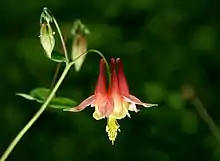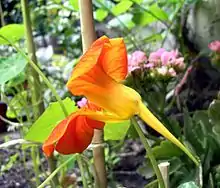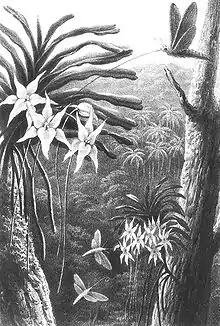Nectar spur
A nectar spur is a hollow extension of a part of a flower. The spur may arise from various parts of the flower: the sepals, petals, or hypanthium, and often contain tissues that secrete nectar (nectaries).[1][2] Nectar spurs are present in many clades across the angiosperms, and are often cited as an example of convergent evolution.[3]


Taxonomic significance

Spur length can be an important diagnostic character for taxonomy, useful in species identification. For example, Yadon's piperia can be distinguished from Platanthera elegans, an extremely similar species in section Piperia (Orchidaceae), by the unusually short length of its spur.[4]
Ecology and evolution
The presence of nectar spurs in a clade of plants is associated with evolutionary processes such as coevolution (two-sided evolution) and pollinator shifts (one-sided evolution).[5] Like variations in floral tube length, variation in nectar spur length has been associated with variation in the lengths of organs on the primary pollinators of the plants, whether being the tongues of moths, the proboscis of flies, or the beaks of hummingbirds.[5] This variation in floral shape can restrict access of pollinators to nectar, limiting the range of potential pollinators.[6]
In a famous historical story, Darwin predicted that the Angraecum sesquipedale, an orchid with an extremely long spur, must be pollinated by a pollinator with an equally long tongue.[7] The pollinator, the sphinx moth Xanthopan morganii praedicta, was found and described 40 years after Darwin made his prediction.
Nectar spurs have been cited as prime examples of “key innovations” that may promote diversification, and play a part in the adaptive radiation of clades.[3] Columbines (Aquilegia) have been studied in depth for the link between their floral nectar spurs and their rapid evolutionary radiations.[3] However, there has also been some refutation to this idea recently, suggesting that the adaptive radiation of Aquilegia may have been due more to climate and habit than to the varying lengths of the nectar spurs.[8][9][10]
Underlying development and genetics
In terms of development, the varying lengths of nectar spurs has been found to be based solely on the anisotropic elongation of cells.[11] However, it still remains to be understood which genes underlie the elongation of cells to form a spur. Are the same genes being co-opted over and over again across the angiosperms to form spurs, or are there several developmental pathways to make a spur?
The genetic basis underlying the development of nectar spurs has been explored in several clades of plant families, such as Linaria and Aquilegia.[12] Studies in model plant Antirrhinum and Arabidopsis identified that type I KNOX SHOOTMERISTEMLESS (STM) genes play a role in the development of spur-like structures.[13] These type I KNOX STM genes also play important roles in the development of the growing tip of the plant, the shoot apical meristem, by controlling cell division and prolonging indeterminate growth.[14] Subsequent gene expression studies confirmed that orthologues of the type I KNOX genes are expressed in the petals of Linaria, a genus of plants with a spur arising from the ventral petal.[15] However, the type I KNOX homologues were not differentially expressed during spur development on the petals of Aquilegia, while certain TCP genes instead were suggested to play a role.[16] These results suggest that nectar spurs may represent a case of convergent evolution on the genetic level, where the nectar spur has developed through different developmental pathways.
List of plants with nectar spurs
The following is an incomplete list of plant clades with nectar spurs.
- Orchids: Satyrium, Disa, Angraecum, Aerangis, Neofinetia, Piperia
- On petals: Aquilegia, Delphinium,[lower-alpha 1] Lentibulariaceae, Viola, Fumarioideae
- On sepals: Impatiens[18]
- From hypanthium: Tropaeolum[2]
Notes
- Delphinium has two spurs on the upper petals and one spur on the upper sepal. The sepaline spur is not a nectar spur because it has no nectar.[17]
References
- Antoń, Sebastian; Kamińska, Magdalena (2015-11-01). "Comparative floral spur anatomy and nectar secretion in four representatives of Ranunculaceae". Protoplasma. 252 (6): 1587–1601. doi:10.1007/s00709-015-0794-5. ISSN 0033-183X. PMC 4628095. PMID 25772682.
- Ronse Decraene, L (2001-11-01). "Floral Developmental Evidence for the Systematic Relationships of Tropaeolum (Tropaeolaceae)". Annals of Botany. 88 (5): 879–892. doi:10.1006/anbo.2001.1525. ISSN 0305-7364.
- Hodges, Scott A. (1997). "Floral Nectar Spurs and Diversification". International Journal of Plant Sciences. 158. No. 6, Supplement: Morphology and Evolution of Flowers (6): S81–S88. doi:10.1086/297508. JSTOR 2475168. S2CID 84429142.
- Morgan & Ackerman, Lindleyana 5:205–211 (1990)
- Johnson, Steven D.; Anderson, Bruce (2010). "Coevolution Between Food-Rewarding Flowers and Their Pollinators". Evolution: Education and Outreach. 3: 32–39. doi:10.1007/s12052-009-0192-6.
- Whittall, Justen B.; Hodges, Scott A. (2007). "Pollinator shifts drive increasingly long nectar spurs in columbine flowers". Nature. 447 (7145): 706–709. Bibcode:2007Natur.447..706W. doi:10.1038/nature05857. PMID 17554306. S2CID 4412955.
- Darwin, Charles R. (1862). On the Various Contrivances by which British and Foreign Orchids are Fertilized by Insects, facsimile edn.
- Bastida, Jesús M.; Alcántara, Julio M.; Rey, Pedro J.; Vargas, Pablo; Herrera, Carlos M. (2009-12-04). "Extended phylogeny of Aquilegia: the biogeographical and ecological patterns of two simultaneous but contrasting radiations". Plant Systematics and Evolution. 284 (3–4): 171–185. doi:10.1007/s00606-009-0243-z. hdl:10261/36746. ISSN 0378-2697. S2CID 5926462.
- Donoghue, Michael J.; Sanderson, Michael J. (2015-07-01). "Confluence, synnovation, and depauperons in plant diversification". New Phytologist. 207 (2): 260–274. doi:10.1111/nph.13367. ISSN 1469-8137. PMID 25778694.
- Fior, Simone; Li, Mingai; Oxelman, Bengt; Viola, Roberto; Hodges, Scott A.; Ometto, Lino; Varotto, Claudio (2013-04-01). "Spatiotemporal reconstruction of the Aquilegia rapid radiation through next-generation sequencing of rapidly evolving cpDNA regions". New Phytologist. 198 (2): 579–592. doi:10.1111/nph.12163. ISSN 1469-8137. PMID 23379348.
- Puzey, Joshua R.; Gerbode, Sharon J.; Hodges, Scott A.; Kramer, Elena M.; Mahadevan, L. (2012-04-22). "Evolution of spur-length diversity in Aquilegia petals is achieved solely through cell-shape anisotropy". Proceedings of the Royal Society of London B: Biological Sciences. 279 (1733): 1640–1645. doi:10.1098/rspb.2011.1873. ISSN 0962-8452. PMC 3282339. PMID 22090381.
- Glover, Beverley J.; Airoldi, Chiara A.; Brockington, Samuel F.; Fernández-Mazuecos, Mario; Martínez-Pérez, Cecilia; Mellers, Greg; Moyroud, Edwige; Taylor, Lin (2015-05-01). "How Have Advances in Comparative Floral Development Influenced Our Understanding of Floral Evolution?". International Journal of Plant Sciences. 176 (4): 307–323. doi:10.1086/681562. ISSN 1058-5893. S2CID 59126705.
- Golz, John F.; Keck, Emma J.; Hudson, Andrew (2002-04-02). "Spontaneous mutations in KNOX genes give rise to a novel floral structure in Antirrhinum". Current Biology. 12 (7): 515–522. doi:10.1016/S0960-9822(02)00721-2. ISSN 0960-9822. PMID 11937019.
- Barton, M. K. (2010-05-01). "Twenty years on: The inner workings of the shoot apical meristem, a developmental dynamo". Developmental Biology. Special Section: Morphogenesis. 341 (1): 95–113. doi:10.1016/j.ydbio.2009.11.029. PMID 19961843.
- Box, Mathew S.; Dodsworth, Steven; Rudall, Paula J.; Bateman, Richard M.; Glover, Beverley J. (2011-11-01). "Characterization of Linaria KNOX genes suggests a role in petal-spur development". The Plant Journal. 68 (4): 703–714. doi:10.1111/j.1365-313X.2011.04721.x. ISSN 1365-313X. PMID 21790812. S2CID 25765402.
- Yant, Levi; Collani, Silvio; Puzey, Joshua; Levy, Clara; Kramer, Elena M. (2015-03-22). "Molecular basis for three-dimensional elaboration of the Aquilegia petal spur". Proceedings of the Royal Society of London B: Biological Sciences. 282 (1803): 20142778. doi:10.1098/rspb.2014.2778. ISSN 0962-8452. PMC 4345449. PMID 25673682.
- Jabbour, Florian; Renner, Susanne S. (2012-11-01). "Spurs in a spur: Perianth evolution in the Delphinieae (Ranunculaceae)". International Journal of Plant Sciences. 173 (9): 1036–1054. doi:10.1086/667613. ISSN 1058-5893. S2CID 59128580.
- Travers, Steven E; Temeles, Ethan J; Pan, Irvin (2003-02-01). "The relationship between nectar spur curvature in jewelweed (Impatiens capensis) and pollen removal by hummingbird pollinators". Canadian Journal of Botany. 81 (2): 164–170. doi:10.1139/b03-014. ISSN 0008-4026.